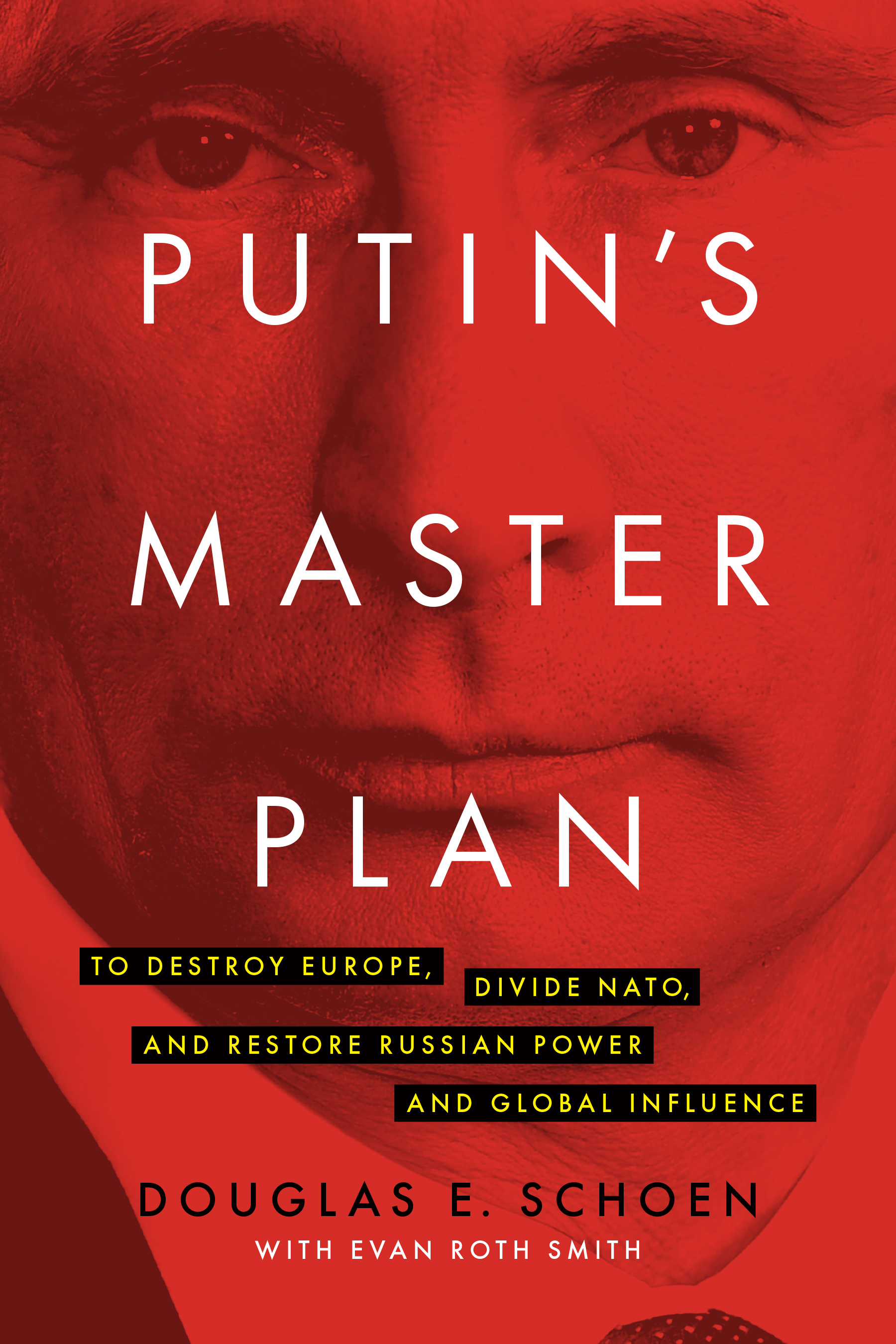© 2016 by Douglas E. Schoen and Evan Roth Smith
All rights reserved. No part of this publication may be reproduced, stored in a retrieval system, or transmitted, in any form or by any means, electronic, mechanical, photocopying, recording, or otherwise, without the prior written permission of Encounter Books, 900 Broadway, Suite 601, New York, New York, 10003.
First American edition published in 2016 by Encounter Books, an activity of Encounter for Culture and Education, Inc., a nonprofit, tax exempt corporation. Encounter Books website address: www.encounterbooks.com
The paper used in this publication meets the minimum requirements of ANSI/NISO Z39.48-1992 (R 1997) (Permanence of Paper).
FIRST AMERICAN EDITION
LIBRARY OF CONGRESS CATALOGING-IN-PUBLICATION DATA
Names: Schoen, Douglas E., 1953– | Smith, Evan Roth.
Title: Putin’s master plan: to destroy Europe, divide NATO, and restore Russian power and global influence / by Douglas E. Schoen with Evan Roth Smith.
Description: New York: Encounter Books, 2016. | Includes bibliographical references and index.
Identifiers: LCCN 2016002498 | ISBN 9781594038907 (ebook)
Subjects: LCSH: Putin, Vladimir Vladimirovich, 1952—Political and social views. | Russia (Federation)—Foreign relations. | Russia (Federation)—Foreign relations—Europe, Western. | Europe, Western—Foreign relations—Russia (Federation) | Russia (Federation)—Foreign relations—United States. | United States—Foreign relations—Russia (Federation) | North Atlantic Treaty Organization. | Hegemony—Russia (Federation) | Aggression (International law) | BISAC: POLITICAL SCIENCE / International Relations / General. | POLITICAL SCIENCE / Political Freedom & Security / International Security.
Classification: LCC DK510.766.P87 S34 2016 | DDC 327.4704—dc23
LC record available at https://lccn.loc.gov/2016002498
Interior page design and composition: BooksByBruce.com
TABLE OF CONTENTS
Introduction
Chapter 1 The Transatlantic Relationship in the Twenty-First Century
Chapter 2 The Russian Century
Putin’s Plan for the Future
Chapter 3 How NATO Is Failing Itself, Europe, and America
Chapter 4 The New Warfare
Russia’s Arsenal of Aggression
Chapter 5 Shadowboxing the Kremlin
Spies, Propaganda, and Cyberwarfare
Chapter 6 Sowing Disorder
Russia, Rogue Regimes, and Terror
Chapter 7 Black-Gold Bully
Russia’s Oil and Gas
Chapter 8 Putin’s Proxies
How Russia Influences Europe
Chapter 9 The United States and Europe
How and Why We Must Fight Back
Afterword
Endnotes
Index
At five in the morning on Thursday, February 27, 2014, unidentified gunmen stormed the Supreme Council of Crimea in Simferopol, the capital of Ukraine’s semiautonomous Crimea region. A local pro-Russian activist camped outside the Supreme Council told journalists that the gunmen “didn’t look like volunteers or amateurs, they were professionals. This was clearly a well-organized operation. . . . Who are they? Nobody knows. It’s about 50–60 people, fully armed.”1 The mysterious gunmen took down the Ukrainian flag that flew over the Supreme Council and raised a Russian flag in its place. All across the Crimean peninsula, taking advantage of the early morning light, dozens of teams of unidentified, heavily armed soldiers seized key government, military, and infrastructure sites; raised Russian flags; and rebuffed all questioners.2 Soon, the world had a name for these uniformed but unidentified soldiers who had materialized to take control of Crimea in a matter of hours: “Little Green Men.”
They didn’t come from Mars but from Russia, on the direct order of Russian president Vladimir Putin. Analysts who have observed Putin’s decadelong pattern of aggressive interference in Ukraine quickly recognized his hand in Crimea’s seizure. The rapid and violent escalation of Russian military and political involvement in Ukraine opened a new chapter in Putin’s bloody project to reestablish Russia as a regional and global power.
Soon, it became clear to the world that the Little Green Men were Russian Spetsnaz forces, and Putin himself would eventually admit as much.3 Putin moved quickly to consolidate control of Crimea and annex it to Russia. Within a month, Crimea had switched its clocks to Moscow time.4 Putin’s illegal invasion and annexation of Crimea would be followed by Russian sponsorship of a violent separatist movement in Eastern Ukraine.5 As of this writing, Russian-backed separatists continue to do battle with the Ukrainian military in and around Donetsk and Lugansk, costing thousands of lives and threatening to plunge Ukraine into political, economic, and social catastrophe.
While Putin’s forces were still establishing control of Crimea, before most media or politicians had fully acknowledged or grasped the seriousness of Russia’s speedy land grab, Poland’s then foreign minister, Radosław Sikorski, warned prophetically that “this is how regional conflicts begin. This is a very dangerous game.”6
Sikorski is right. By invading Ukraine, Putin has plunged Europe into a perilous state of conflict and turmoil not witnessed since the darkest days of the Cold War. Since seizing Crimea and starting the war in eastern Ukraine, Russia has conducted cross-border raids into the Baltic States,7 ordered its fighters to buzz US Navy ships,8 and sent nuclear-capable bombers into the airspace of neighboring countries.9 Indeed, Putin has become so aggressive that he risks pushing Russia into a full-blown nuclear confrontation with NATO.10 During the Cold War, the world was lucky to avoid a nuclear war between America and the Soviet Union. We may need to be that fortunate again.
Putin’s ambitions are not limited to the territory of the former Soviet Union, though he has begun to question whether former Soviet states are even legally independent of Russia.11 Putin has targeted countries like Bulgaria12 and Slovakia13 for expanded Russian influence as well. Never one to miss an opportunity, Putin has taken advantage of the long-running feud between Greece and its European creditors to position Russia as an alternative ally and potential financial savior for the beleaguered, bitter Greeks.14 Putin’s vision extends beyond Europe, too: he has intervened in Syria to support Bashar al-Assad15 and transferred nuclear technology to Iran’s ayatollahs,16 and he has cut trade deals with North Korea’s lunatic Kim dynasty.17
To some, Putin may seem like an unpredictable tyrant, obsessed with power, violence, and conquest, who lashes out at neighboring countries impulsively and spasmodically. We believe the truth is much more subtle, and even more formidable, than either of these characterizations: Putin is a calculating master of geopolitics
